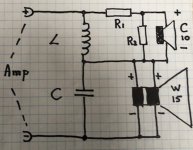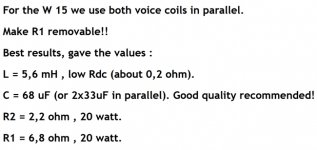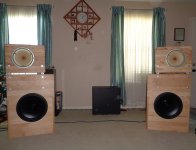"Z: 4 ohm parallel" which means each voice coil is 8 ohms.
"Re: 3.08 ohm parallel" which means the DC resistance.
Re is the resistance of the copper wire the voice coil is made up from.
This resistance is constant for direct current and for all frequencies of alternating current.
Since the copper wire is wound as a coil it also has an inductive "resistance" that increases with increased frequency.
Each turn of wire in the coil lays beside the next turn of wire and forms a capacitor.
A capacitor has a capacitive "resistance" which decreases with increasing frequency.
Don't worry about Re since Re only applies if you feed direct current to the speaker (which never happens).
"Re: 3.08 ohm parallel" which means the DC resistance.
Re is the resistance of the copper wire the voice coil is made up from.
This resistance is constant for direct current and for all frequencies of alternating current.
Since the copper wire is wound as a coil it also has an inductive "resistance" that increases with increased frequency.
Each turn of wire in the coil lays beside the next turn of wire and forms a capacitor.
A capacitor has a capacitive "resistance" which decreases with increasing frequency.
Don't worry about Re since Re only applies if you feed direct current to the speaker (which never happens).
Last edited:
There is two voice coils within the driver, each is of 8 ohm impedance. Paralleled their combined impedance is 4ohms. The DC resistance of each voice coil should be 6.16 ohms.
Measure it with a digital multimeter. The combined DC resistance (when paralleled) will be 3.08 ohms.
Do not wire the fullrange directly across the woofer unless you wire in series with that configuration a high wattage resistor of at least 2.2 ohms (absolute minimum value).
The resistor will maintain the minimum load resistance seen by the amplifier's output stage at 4.2 ohms. This will keep your amplifier safe but will waste power within that resistor.
The overall sound from that arrangement without any crossover included with it is likely to be underwhelming to say the least.
Loudspeaker design is an exhaustive learning curve in achieving the very best outcome.
C.M
Measure it with a digital multimeter. The combined DC resistance (when paralleled) will be 3.08 ohms.
Do not wire the fullrange directly across the woofer unless you wire in series with that configuration a high wattage resistor of at least 2.2 ohms (absolute minimum value).
The resistor will maintain the minimum load resistance seen by the amplifier's output stage at 4.2 ohms. This will keep your amplifier safe but will waste power within that resistor.
The overall sound from that arrangement without any crossover included with it is likely to be underwhelming to say the least.
Loudspeaker design is an exhaustive learning curve in achieving the very best outcome.
C.M
Last edited:
4 ohm, 8 ohm? 8 ohm, 4 ohm? 😀
Well at least we have now seen the specs. What Tweet and Emtor say is above is correct.
Also, as stated, wiring the woofer and tweeter in series is not the way to go. You'll get sound, but it won't be the best that you can do.
Well at least we have now seen the specs. What Tweet and Emtor say is above is correct.

Also, as stated, wiring the woofer and tweeter in series is not the way to go. You'll get sound, but it won't be the best that you can do.
AE left speaker left side connections 5.6 Ohms
left speaker right side connections 6.1 Ohms
Same for right speaker.
But weird, when I connected the left side connections to the right side connections they measured exactly the same:
left speaker right side connections 6.1 Ohms
Same for right speaker.
But weird, when I connected the left side connections to the right side connections they measured exactly the same:
Ponger suggested this since the full range drivers are the same and the woofers are similar:
Audio Dandy - How to enjoy High Resolution Audio
Here's the x-over

and it's list of stuff to buy

Here are measurements I made with a multimeter:
Left woofer left side connections 5.6 Ohms
Left woofer right side connections 6.0 Ohms
The right woofer measurements were pretty much identical
Weird thing, when I connected the dual voice coils in parallel then in series, measurements were the exact same 2.9 Ohms 😕
Seems my measurements are all different from the data from the manufacturer.
So would the above crossover still work with my drivers?
Audio Dandy - How to enjoy High Resolution Audio
Here's the x-over

and it's list of stuff to buy

Here are measurements I made with a multimeter:
Left woofer left side connections 5.6 Ohms
Left woofer right side connections 6.0 Ohms
The right woofer measurements were pretty much identical
Weird thing, when I connected the dual voice coils in parallel then in series, measurements were the exact same 2.9 Ohms 😕
Seems my measurements are all different from the data from the manufacturer.
So would the above crossover still work with my drivers?
Well you may as well as give 'Audio Dandy' a go, at least be pepared to modify the crossover design to suit your taste. You'll also have to replicate his 'wood work' to maintain some integrity of the design. Your woofer is about 3 db more sensitive than the one he is using so you'll need to attenuate it with a resistor. This is where you'll experiment a bit.
The L and C components in the crossover by themselves (shown in the above pic) forms a series resonant circuit, which at one particular frequency their reactances will cancel to produce a short circuit for your amplifier.
So, don't play audio through to your speakers if both of the drivers have been disconnected from the above crossover. Always leave one driver in circuit with the crossover when playing any audio at volume. Series crossovers are tricky in getting the balance right that's why parallel networks are generally preferred.
Best of luck with your project and Christmas cheer to all.
C.M
The L and C components in the crossover by themselves (shown in the above pic) forms a series resonant circuit, which at one particular frequency their reactances will cancel to produce a short circuit for your amplifier.
So, don't play audio through to your speakers if both of the drivers have been disconnected from the above crossover. Always leave one driver in circuit with the crossover when playing any audio at volume. Series crossovers are tricky in getting the balance right that's why parallel networks are generally preferred.
Best of luck with your project and Christmas cheer to all.
C.M
Purchased Goertz copper foil inductors for the woofers. How do you connect copper foil inductors? Do they have a positive and negative, if yes which is which? Pictures would be appreciated if you've got them. if not a 1,2,3 format would be easiest to understand.
Inductors do not have positive or negative. Unless you believe some audiophoolery, like directional fuses.
Thanks adason for letting me know inductors have no positive or negative. As I said, I've already purchased the inductors. So I take it since your recommendation is for active crossovers and biamping, you have no or negative experience with passive crossovers. I'm just trying to get advice on connecting the "copper foil" inductors since they're different from regular inductors.
There is nothing different about copper foil inductor than wire wound. Unless very high current stress and perhaps wire vibration. Less air gap is not issue, wire would may have more rounds, but that does not seems to reflect on price, you pay more for foil, since its a nuisance to wind them. Will you hear the difference? No.
Purchased Goertz copper foil inductors for the woofers. How do you connect copper foil inductors? Do they have a positive and negative, if yes which is which? Pictures would be appreciated if you've got them. if not a 1,2,3 format would be easiest to understand.
Do not buy expensive crossover components for your first pass at the crossover (unless you are building a proven design that you are replicating).
Even if you have simulated a crossover, you are likely to want to voice / change it. This is even more likely with textbook or other "guestimates".
So - buy non-polar electrolytic caps for bigger values or mylar or other cheap options. With inductors - it only really matters that your DC resistance is suitable (and not rob the speaker of 1 or 2dB sensitivity if you go for 20awg or similar). Again - big values - buy cored inductors (e.g. steel laminate).
Fancy foil / film inductors and caps may look and feel nice, but the jury is out on whether you can actually hear the difference over a good air cored inductor / polyprop cap.
Getting the right values (within tolerances) - and matching them across 2 speakers is way, way more important than the boutique factor.
Yes, what Dave just said. A crossover with the correct values and topology build using cheap parts will sound better than an out of wack crossover with $$$$ boutique parts.
Find the crossover first, then buy the expensive parts if you want. Don't rush into it.
Find the crossover first, then buy the expensive parts if you want. Don't rush into it.
I'm just trying to get advice on connecting the "copper foil" inductors since they're different from regular inductors.
Stop thinking they're different from regular inductors. A Michelin tire isnt any "different" than a Walmart Douglas in the way it connects to the rim. It's a better tire, but "connects" in the same way.
Every inductor I've ever seen has two wires. You connect them up in the obvious way. Doesnt matter which "end" is which.
Unless you want the winding direction to be the same as the coriolis effect in the northern hemisphere, in which case you could just flip it over to see which way sound best, before gluing it down. (I'm, of course, just pulling your leg)
Pano, based off of your graphs in posting #18 I bought a 3.9 mH. So you're all saying tin the ends and solder like regular, (when I find the exact value that sounds good to my ears)? jjasniew, you say "obvious." I'm a novice, this is my very 1st speaker build. I'm learning as I go. I appreciate the guidance. Keep it coming.
- Home
- Loudspeakers
- Multi-Way
- Need construction advice for OB

 Happy Holidays!!
Happy Holidays!!